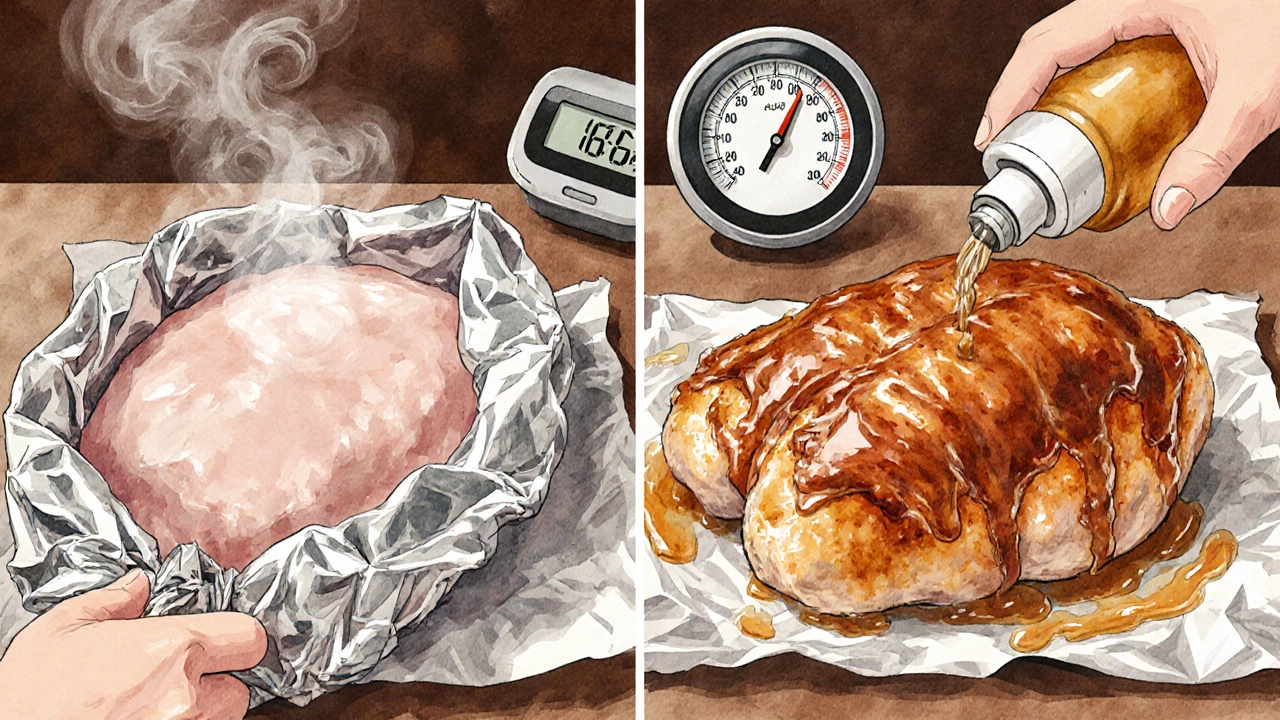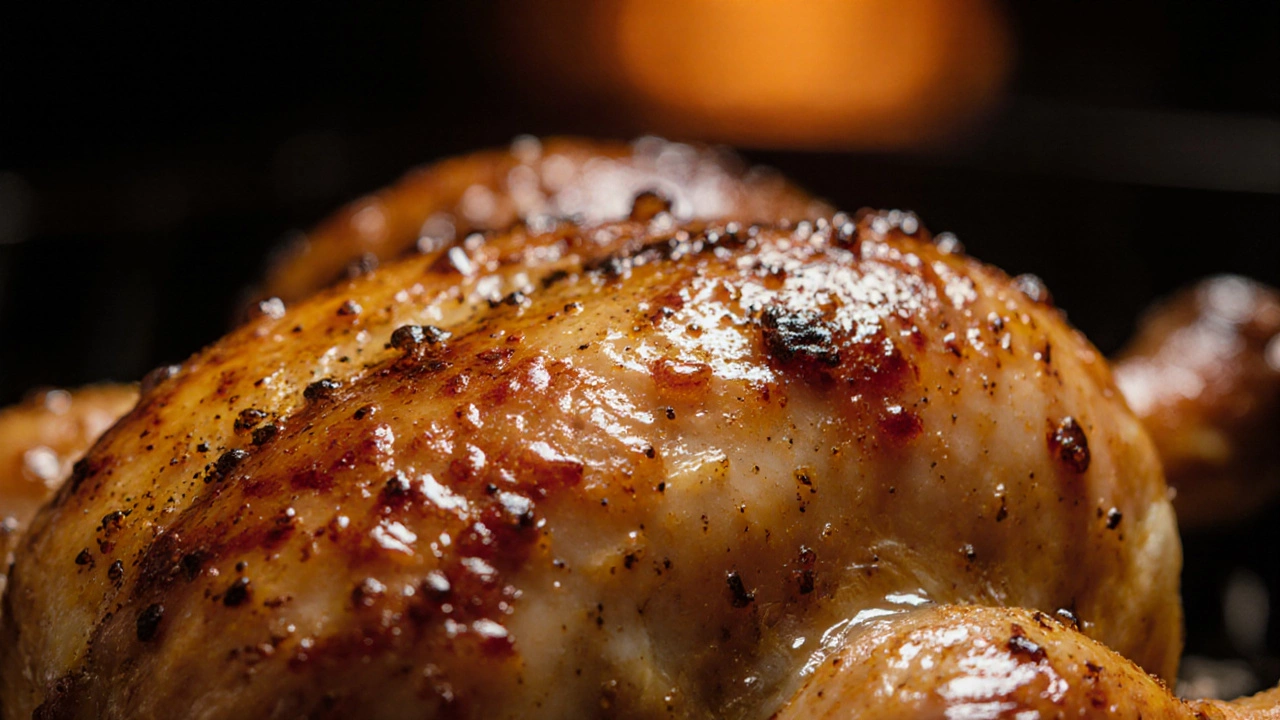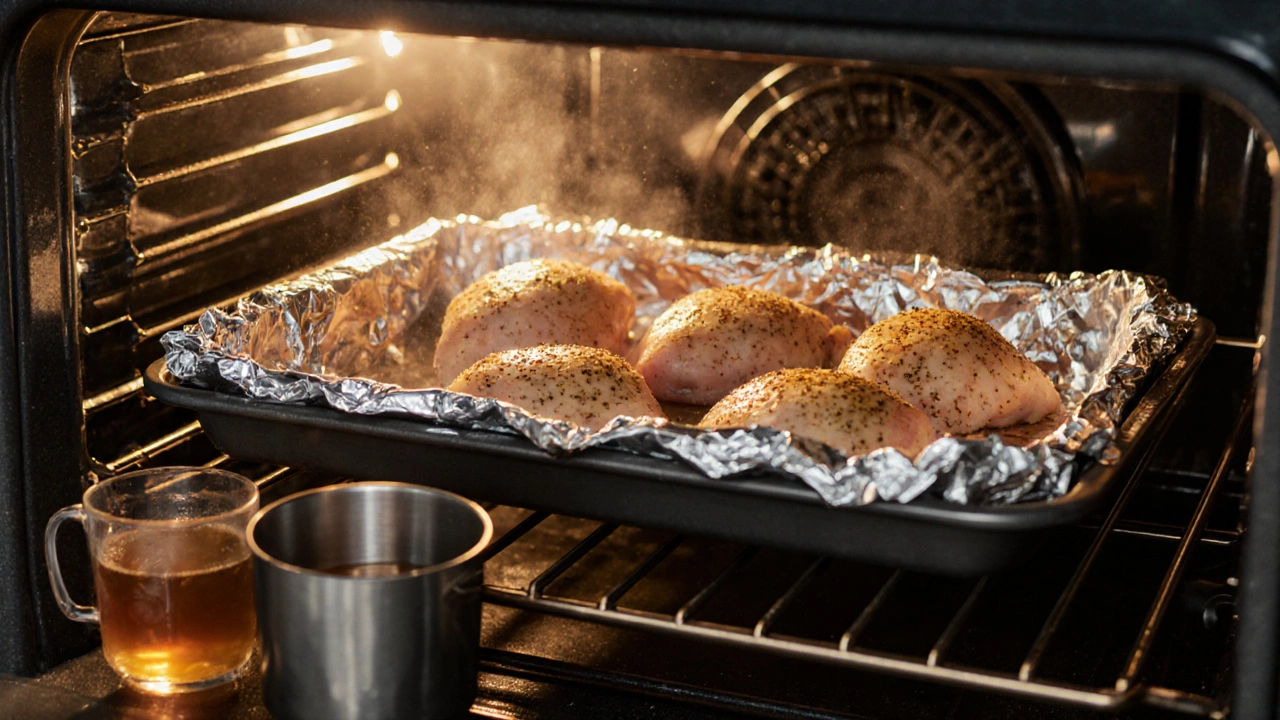Chicken Baking Method Decision Guide
Choose Your Chicken Type
Desired Outcome
Cooking Method
Temperature Target
165°F (74°C) is the safe minimum internal temperature for all chicken cuts.
Key Takeaways
- Covering chicken traps steam, keeping meat juicy but can soften the skin.
- Cooking uncovered lets the skin crisp and deepens flavor, but risks dryness if overdone.
- Start covered for the first half of cooking, then finish uncovered for a golden crust.
- Use foil, a tight‑fitting lid, or a pan‑cover that matches your oven‑safe cookware.
- Monitor internal temperature; 165°F (74°C) is safe for all cuts.
When you ask, bake chicken covered or uncovered, the answer isn’t a simple yes or no. It depends on the cut, the skin, the sauce, and the texture you want. Below we break down the science, the practical steps, and the common pitfalls so you can decide on the fly.
Baked chicken is chicken that is cooked in a dry‑heat oven, usually on a roasting pan or baking sheet can be prepared in many ways, but the cover‑or‑no‑cover question is the most debated among home cooks.
How Covering Changes the Cooking Environment
Covering creates a mini‑oven inside your oven. The cover (foil, lid, or a second pan) traps moisture that vaporizes from the meat, forming a humid micro‑climate. This humidity does two things:
- It slows down evaporative cooling, so the chicken stays juicier.
- It reduces the Maillard reaction on the surface, which means the skin stays soft.
When you leave the chicken uncovered, the hot air can directly contact the skin, driving off water and intensifying browning. The result is a crisp, caramelized exterior, but the interior can lose up to 15% of its moisture if the cooking time is too long.
When to Cover: Best‑Fit Scenarios
Here are the most common situations where covering pays off:
- Skin‑on chicken pieces that still have the outer layer of skin that you plan to baste or glaze. The cover protects the glaze from burning while allowing flavors to meld.
- Bone‑in cuts such as thighs, drumsticks, or whole halves that need extra time to reach safe temperature.
- Recipes that involve a liquid base-think braised chicken, a tomato sauce, or a honey‑mustard glaze. The liquid stays in the pan instead of splattering.

When to Skip the Cover: Best‑Fit Scenarios
Leave the chicken exposed when you want a crunchy skin or a roasted flavor that comes from caramelized dry heat:
- Skinless breast boneless, skin‑removed chicken breast that you’re grilling or pan‑searing first and then finishing in the oven.
- High‑heat roasting (425°F/220°C or above) where a short, intense heat gives a crackly crust.
- When you’re planning to broil the final minute or two under the oven’s top heating element to add extra color.
Practical Guide: Covering Techniques
Pick the cover that matches your cookware:
- Aluminum foil thin, disposable metal sheet that can be molded to fit a pan. Ideal for a quick seal; just crimp the edges to keep steam in.
- Oven‑safe lid a fitted lid made of stainless steel, cast iron, or tempered glass. Re‑useable and sturdy; great for long‑cook dishes.
- Second roasting pan an inverted pan placed on top of the chicken to trap steam. Works well if you don’t have foil or a lid.
Step‑by‑step for a classic roast:
- Preheat oven to 375°F (190°C).
- Season the bone‑in chicken pieces thighs, drumsticks, or whole leg quarters with salt, pepper, and herbs.
- Place the chicken skin‑side up on a roasting pan deep, oven‑safe tray with a rack.
- Cover loosely with foil, making sure the foil doesn’t touch the skin.
- Bake for 25‑30 minutes, then remove the foil.
- Increase oven temperature to 425°F (220°C) and bake another 10‑15 minutes until the skin is golden and the internal temperature measured with a probe, reaches 165°F (74°C).
- Let rest 5 minutes before serving.
Pro Tips for Perfect Results
- Start covered, finish uncovered. The first half of cooking locks in moisture; the last 10‑15 minutes give you that crispy skin.
- Use a thin glaze (honey, BBQ, mustard) and add it after the foil comes off. This prevents the sugars from burning.
- For extra flavor, place a cup of water or broth in the pan when you cover. The steam will keep the meat tender while the liquid adds a subtle taste.
- If you’re cooking a whole bird, tent the breast with foil while the thighs finish, then remove the tent for the final crisp.
- Check the temperature in the thickest part of the meat, not near the bone. A digital probe gives the most accurate read.

Common Pitfalls and How to Fix Them
Soggy skin. If the skin remains soft after the uncovered phase, switch the oven to broil for 2‑3 minutes, watching closely to avoid burning.
Dry breast meat. Pull the chicken out as soon as the thermometer reads 160‑162°F (71‑72°C) and let residual heat finish the cooking; this prevents over‑cooking.
Stuck foil. Lightly oil the foil side that contacts the pan, or use parchment paper under the chicken before covering.
Comparison: Covered vs Uncovered
| Aspect | Covered | Uncovered |
|---|---|---|
| Moisture retention | High - steam locked in | Medium - surface dries |
| Skin crispness | Soft to slightly crisp | Very crisp, caramelized |
| Cooking time | ~10‑15 minutes longer | Standard time |
| Flavor concentration | Intensified by steam | Enhanced by browning |
| Best for | Bone‑in, skin‑on, saucy dishes | Skinless breasts, high‑heat roasts |
Mini FAQ
Frequently Asked Questions
Should I cover chicken the whole time I bake it?
No. Most chefs recommend covering for the first half to keep the meat moist, then removing the cover to let the skin brown and crisp.
What type of cover works best?
Aluminum foil is the most flexible and easy to seal. An oven‑safe lid gives a tighter seal and can be reused. Choose whichever fits your pan snugly.
How do I know when the chicken is done?
Insert a probe into the thickest part; 165°F (74°C) is the safe target. For extra juiciness, pull the chicken at 160°F (71°C) and let it rest.
Can I add sauce while the chicken is covered?
Yes. Adding a sauce or broth under the foil creates a braising effect that infuses flavor and keeps the meat tender.
What if I forget to remove the foil?
The skin will stay soft. Switch to broil for a few minutes, or increase the oven temperature and bake uncovered for 5‑10 minutes to regain crispness.

